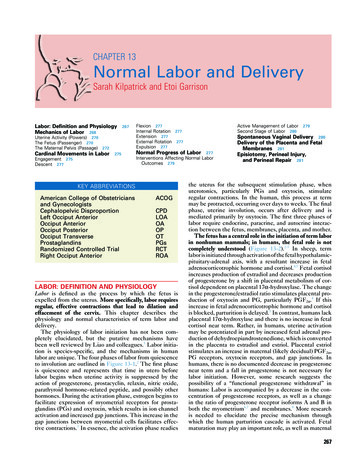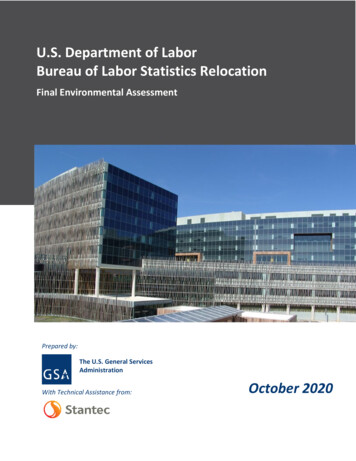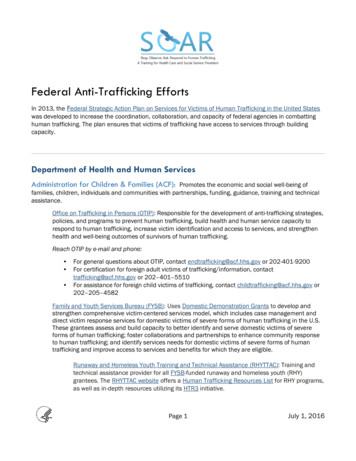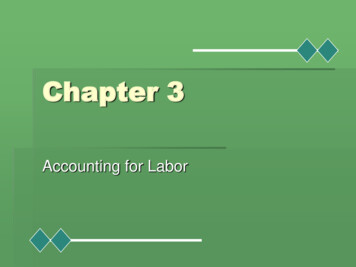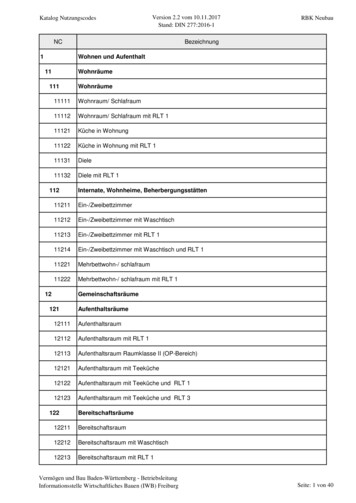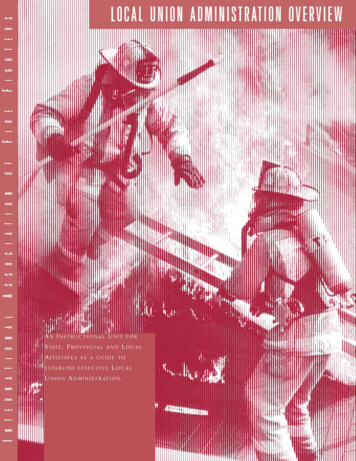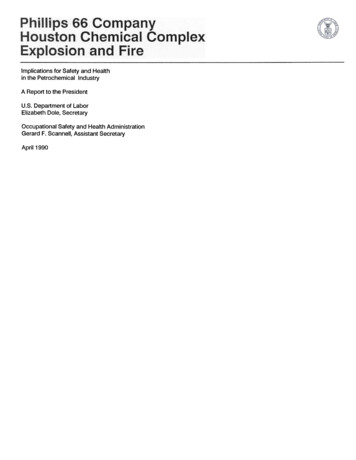
Transcription
Implications for Safety and Healthin the Petrochemical IndustryA Reportto thePresidentu.s. Department of LaborElizabeth Dole, SecretaryOccupational Safety and Health AdministrationGerard F. Scannell, Assistant SecretaryApril 1990
u.s.DEPARTMENTOFFICEOFLABOROF THE SECRETARYWASHINGTON.D.C.20210April26,1990The Honorable George BushPresident of the United StatesThe White HouseWashington, D.C. 20500Dear Mr. President:In the early afternoon of October 23, 1989, a massive and devastating explosion andfire ripped through the Phillips 66 Company's Houston Chemical Complex (HCC),killing 23 persons--all working at the facility--and injuring more than 130 others. Inaddition to the tragic loss of life and injuries, the explosion affected all facilities withinthe complex, causing nearly three-quarters of a billion dollars worth of damage. Thetwo polyethylene production plants nearest the source of the blast were destroyed, andin the HCC administration building nearly one-half mile away, windows were shatteredand bricks ripped out. The initial explosion had the force of 2.4 tons of TNT and wasequivalent to an earthquake registering 3.5 on the Richter Scale.The Occupational Safety and Health Administration (OSHA) of the U.S. Departmentof Labor, the Federal agency charged with the responsibility for assuring a safe andhealthful workplace, arrived at the Phillips site within an hour of the accident. Theother Federal agencies,particularly the U.S. Environmental Protection Agency (EPA),State agencies,and emergency responders--whichhave important responsibilities forpublic safety, the environment, firefighting, and search and rescue--also respondedimmediately to the disaster. That very afternoon, I dispatched the newly confirmedAssistant Secretary for OSHA, Gerard F. Scannell, to the scene, and by week's end,I promised a complete and comprehensive report to you on the findings of the OSHAinvestigation.OSHA's comprehensive investigation of the accident was initiated immediately. Theobjective of the investigation was not only to determine the cause of the accident andany violations of the Occupational Safety and Health Act (OSH Act) that might haveoccurred, but also to identify steps that the petrochemical industry, labor, OSHA, andothers should take to prevent similar accidents in the future. During the search andrescue effort, OSHA provided technical assistanceto the responders, includingfirefighters, police, and medical personnel. OSHA also coordinated its activities withthe Federal, State, and local agenciesthat responded to the accident, including EPA.l
The Department expanded its investigation beyond the Phillips event to include areview of what are believed to be some of the most critical issueswithin thepetrochemical industry, focusing particularly on those sectors of the industryidentified as having the greatest potential for catastrophic accidents. This report,therefore, in addition to OSHA's findings from its investigation of the Phillips 66accident in Pasadena,Texas, includes a profile of the petrochemical industry, ananalysis of its accident history, and a preliminary review of industry work practices,particularly the relationship between plant personnel and outside contractorpersonnel. Labor organizations, industrial firms, trade associations,academicinstitutions, and other professional organizations have all contributed to thedevelopment of this dustry.Attogetherseniormaintenancearewill accidentshaveproposedtothe and final mtoprotectmitigateresultsagainstof of of anytheotherthatsafety might wewillbringindustry,andfindings.Accidents such as this can and must be prevented through better chemical processsafety management, better training of workers, and better emergency responseprocedures. This report identifies those procedures, policies, and regulations thatwarrant improvement and acts as a catalyst to assure that labor, industry, and theFederal Government work together to improve safety in the petrochemical industry.The Department of Labor and I grieve the loss of these workers. We arecommitted to taking the necessary steps to prevent such a loss in the future.C le)
N1IITHE ACCIDENT5IIIOSHA's INVESTIGATION13NINTERAGENCY COORDINATION15vCAUSES OF THE PHILLIPS21VIFINDINGS OF OSHA's INVESTIGATION25VIIINTERN29VIIIOSHA's PROGRAM TO PREVENT PETROCHEMICALACCIDENTS33IXINDUSTRY AND LABOR ACfIVITY39xINDUSTRY PROFILE43XIINDUSTRY ACCIDENT HISTORY45A STUDY OF SAFETY AND HEALlliPRAcrlCESRELATING TO lliEUSE OF CONTRAcrORSINSELECfED PETROCHEMICALSEcrORS63CONCLUSION69AcrlONS7166 ACCIDENTA TI O N AL A CfNrrYREFERENCES77) v
fc LISTOF ILLUSTRATIONSPageFigure1.2.3.4.Phillips 66 Company Houston Chemical Complex, Pasadena,TXPartial Equipment Location Plan Reactor Area-Plant VTypical Piping Settling Leg ArrangementDEMCO Valve6789Chart1. Federal OSHA Inspections of the Petrochemical Industry2. Serious Violations versus Total Violations in thePetrochemical Industry3. Federal OSHA Accident Investigations of the PetrochemicalIndustry4. Federal OSHA Fatality Investigations of the PetrochemicalIndustry5. Federal OSHA Inspections of Phillips 666. Phillips 66 Serious Violations versus Total Violations7. Accident Investigations Major Contributing Factors in thePetrochemical Industry FY 1989LIST50505252535354OF TABLESTable1.2.3.4.5.6.7.8.9.Petrochemical Industry EmploymentRecordable Injury Incidence Rates 1973 -1988Recordable Injury Incidence Rates 1985 -1988Lost Workday Injury Incidence Rates 1973 -1988Lost Workday Injury Incidence Rates 1985 -1988Distribution of Losses by Type of ComplexCause of LossEquipment InvolvedType of Loss by ComplexVI444747484857575858
EXECUTIVEmEPHILLIPSSUMMARY66 COMPANY HOUSTON CHEMICALEXPLOSION AND FIRECOMPLEXOn October 23, 1989, at approximately 1:00 p.m., an explosion and (ire rippedthrough the Phillips 66 Company Houston Chemical Complex in Pasadena,Texas.Twenty-three workers were killed and more than 130 were injured. Propertydamage was nearly three-quarters of a billion dollars. Secretary of Labor ElizabethDole pledged a thorough and comprehensive investigation of the accident todetermine the cause and to recommend actions to prevent such accidents in thefuture.There was a need for such an investigation and for this report. Since the disastrousrelease of methyl isocyanate from a Union Carbide facility in Bhopal, India, inDecember 1984, the Department of Labor's Occupational Safety and HealthAdministration (OSHA) has been concerned about the possibility of a catastropheoccurring in a petrochemical plant in this country.OSHA's investigations in 1984 and 1985 of all U.S. producers and users of methylisocyanate and of a subsequent accident at a Union Carbide facility in WestVirginia indicated the need to look beyond existing OSHA standards to the bestcompany and industry control measuresand systemsfor managing the hazards ofthe chemical process.OSHA developed a "system safety" approach to chemical accident investigationsthrough a special emphasis program of inspections at 40 chemical-processingplantsin 1985 and 1986 (ChemSep). At the same time, the agency began to revise itsexisting standard for safe handling and storage of hazardous materials to includerequirements for management systemsthat would ensure the safety of the chemicalprocess. This effort was the precursor of the agency's current rulemaking for astandard for Process Safety Management of Highly Hazardous Chemicals.The catastrophe at the Phillips Complex underscored the need for effectiveimplementation of good safety management systemsin the petrochemical industryand raised questions about diffused responsibility for employee safety at worksiteswhere one or more contractors are engaged in work for a company. OSHA hadaddressedthis issue at construction sites, but not at petrochemical plants like thePhillips Complex, where an engineering contractor was regularly employed toperform key maintenance operations and was involved in the October 1989 disaster.The Department of Labor therefore determined that OSHA's investigation of thistragic accident would be broad in scope and would examine the underlying causesVl1)'-"'
consequencesand that the Department would report to the President with findingsand recommendations.The Phillips Complex produces high-density polyethylene, a plastic material used tomake milk bottles and other containers. Prior to the accident, the facility producedapproximately 1.5 billion pounds of the material per year. It employed 905company employees and approximately 600 daily contract employees, who wereengaged primarily in regular maintenance activities and new plant construction.The accident resulted from a release of extremely flammable process gasesthatoccurred during regular maintenance operations on one of the plant's polyethylenereactors. The evidence shows that more than 85,000 pounds of highly flammablegaseswere released through an open valve. A vapor cloud formed and traveledrapidly through the polyethylene plant. Within 90 to 120 seconds,the vapor cloudcame into contact with an ignition source and exploded with the force of 2.4 tons ofTNT.OSHA investigated the causesof the accident concurrently with the investigation ofpossible violations of the Occupational Safety and Health Act (OSH Act). Duringthe emergency response to the accident and during the investigation, OSHAcoordinated with the U.S. Environmental Protection Agency (EPA) as well as otheragencies. In the course of this extensive investigation, thousands of pages ofdocuments relating to the facilities, the equipment, and company and contractorwork practices were reviewed; scores of witnesseswere interviewed; and criticalpieces of evidence from the debris were subjected to laboratory and other tests.OSHA's investigation revealed that a number of company audits, which were doneby Phillips' own safety personnel as well as by outside consultants, had identifiedunsafe conditions, but had been largely ignored. The investigation further revealedan absence of effective management systemsthat resulted in the failure:.to prevent the uncontrolled release of flammable vapors.to minimize the effects of a release of flammable vapors, including theelimination of possible ignition sources.to provide adequate fire protection.Thus, a citation for willful violations of the OSH Act "general duty" clause has beenissued to Phillips with proposed penalties of 5,660,000. In addition, citations withproposed penalties of 6,200 have been issued for serious violations in the areas ofemergency response, emergency egress,inadequate pre-emergency planning, plantalarm systems,hazard communication, and respiratory protection.V1l1
A citation for willful violations with proposed penalties of 724,000has been issuedto Fish Engineering and Construction (a Phillips maintenance contractor) for failingto obtain the necessaryvehicle and hot work permits when working in thepolyethylene plant. Citations for serious violations with proposed penalties of 5,500 have also been issued for hazards involving inadequate respiratory protectionand deficiencies in the company's hazard communication program; other thanserious violations involving mainly recordkeeping issuesresulted in an additional 100 proposed penalty.As a result of its findings in this investigation, the Department of Labor iscommitted to a course of action directed toward preventing catastrophic chemicalaccidents. The following are the actions the Department has pledged to undertake:I. OSHA will expedite completion of its rulemaking requiring employers toimplement comprehensive chemical process safety management plans for hazardouschemical processes.II. OSHA will revise its current system for setting agency priorities to identify andinclude the risk of catastrophic events in the petrochemical industry.III. OSHA will establish a catastrophe investigation protocol that will include plans,procedures, and an administrative framework to be activated in the event of acatastrophic accident.IV .The Department of Labor will work with EP A to develop a joint investigationstrategy for catastrophic chemical accidents that affect workers within the plant andthe public and the environment outside the plant.v. OSHA will employ all means at its disposal to ensure that every establishmentin the petrochemical industry implements technologies and safe work practices thatare widely accepted and generally used by the industry and its contractors. Theagency will encourage the petrochemical industry to incorporate new technologiesinto chemical processes that would decrease the likelihood of a workplace accident.VI. OSHA will sponsor a conference of industry, labor and government leaders onthe lessons learned from the Phillips disaster. The results of the study on thepetrochemical industry's practice of contracting out maintenance work will bepresented. Representatives from other Federal agencies and foreign countries willbe invited to participate in a discussion of ways to improve worker safety and healthin the petrochemical industry.VII. OSHA will urge agenciesinvolved in the collection of information on chemicalaccidents and incidents to establish an interagency working group to review availabledata systemswith a view to including more information on the causes of chemicalaccidents.ix
VIII.OSHA will periodically publish ChemAlert bulletins.OSHA's investigation of the Phillips catastrophe confirms the importance of(1) determining not only the precipitating circumstancesof an accident but theunderlying causes,(2) identifying the actions needed to prevent recurrence, and(3) widely disseminating the knowledge gained. Above all, the actions proposed inthis report underscore the urgent need for increased attention to the establishedprinciples of process safety management.The most critical responsibilities for chemical process safety rest not with government agenciesbut with industry, and specifically with each petrochemical producer,at each location or workplace. Through regulation, enforcement, technical assistance, training and other means, OSHA acts to ensure that employers fulfill theirresponsibility with regard to chemical process safety for employees as well as othertypes of worker hazards. OSHA's role, however, is not that of a supervisory bodyfor the industry or for the individual plant; as specified in the OSH Act, theresponsibility for the safe operation of any workplace always remains with theemployer.x
contents chapter page executive summary vll i introducrlon 1 ii the accident 5 iii osha's investigation 13 n interagency coordination 15 v causes of the phillips 66 accident 21 vi findings of osha's investigation 25 vii intern a ti o n al a cfnrry 29 viii osha's program to prevent petrochemical accidents 33 ix industry and labor acfivity 39 x industry profile 43


